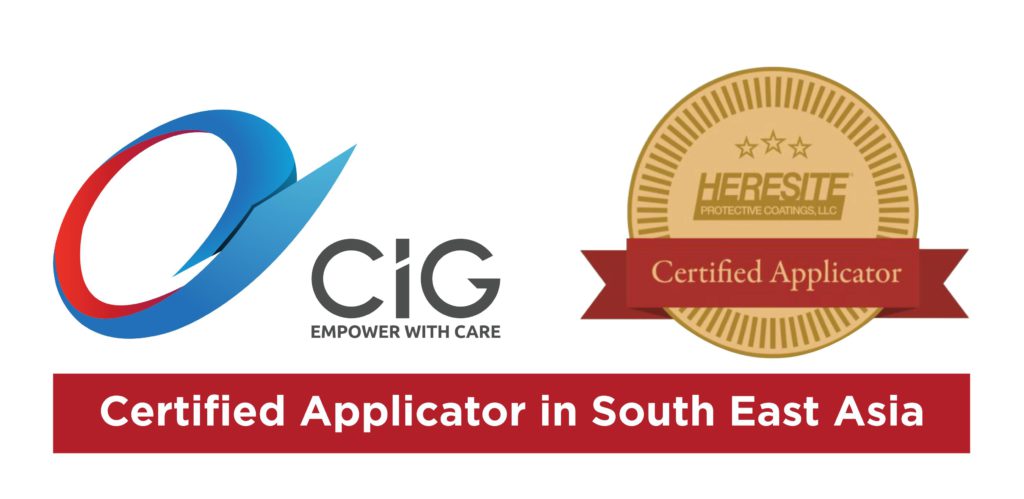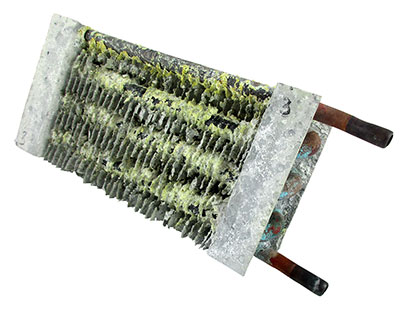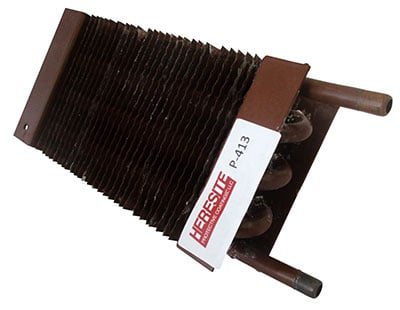
Product
P-413 Baked Phenolic Epoxy
Heresite P-413 is a thin film, high performance coating used principally for coil and radiator heat exchangers as well as other air and fume handling equipment fabricated of light gauge metals. It is the first HVAC-R coil and radiator coating to meet the ISO 12944-9 (formerly ISO 20340) Standard for severe offshore marine environments. The corrosion resistance of Heresite P-413 coatings significantly extends the service life of HVAC-R (heating, ventilation, air conditioning, and refrigeration), and other heat transfer equipment.
In addition to marine and salt air environments, the P-413 family of coatings will withstand exposure to an extensive variety of high and low pH corrosive and chemical fumes and condensate. Because these products are efficient thermal conductors, applied at very thin films, HVAC-R and process equipment coil OEMs have indicated that thermal loss due to the presence of P-413 baked phenolic epoxy coating is <1%.
USE
- Heat exchangers (finned tube, radiators, charge air coolers)
- HVAC-R coils (finned tube and microchannel)
- Fume handling equipment
ENVIRONMENTS
- Marine/salt air environments
- Waste water/sewage plants
- Chemical and refinery operations
- Swimming pools
APPLICATION
- Full immersion
- Flood
- Spray
COLOR
- Brown (as seen in photo)
SAMPLE TEST DATA
- Cyclic weather: ISO 12944-9/ISO 20340: No external damage of coated layer (both with and without a UV topcoat) after 4,200 hours (25 cycles) alternating between salt spray, UV radiation, and temperature shocks
- Static salt spray: ASTM B-117: 6,000+ hours
- Bend test: ASTM-D522: >1/4 inch
- Adhesion 5B – on copper, aluminum, steel, stainless, hot dipped galvanized
- Thermal efficiency impact: <1%
- Food contact: Meets FDA 175.300 for indirect food contact, NSF Certified – ANSI 51 Certification of Coatings for Food Zone – Non Contact
Why use a hydrophilic HVAC topcoat?
Management of condensation and moisture is critical to ensuring the efficient function of HVAC equipment. Equipment operating in high temperature, submerged, or salty environments can suffer from condensation issues, which exacerbate the corrosion process, or lead to the creation of large waer droplets, which force the fan to work harder.
Hydrophilic (or water-loving) coatings or topcoats allow water to spread across a larger area due to the coating’s affinity for water created by a high-energy surface. By contrast, a hydrophobic coating causes the water to bead up because it is repelling the water. While it might seem counterintuitive to learn that a water-loving hydrophilic HVAC topcoat helps to prevent corrosion and improves HVAC unit performance, it’s true. Hydrophilic topcoats lower surface friction, which allows condensation or environmental water to slide off a surface rather than accumulating. Because the condensate spreads out (wicks) across the surface, heat transfer is improved, and unit fans can be run at higher speeds. Hydrophilic topcoats also help control the contact angle of water droplets, which helps manage the disposal of condensates on the heat exchanger’s surface by allowing the condensate to drain to the bottom of the coil into the pan.
Hydrophilic topcoats should be used when:
- Water beads up on the surface of the unit and is blown into undesired areas (water carry-over)
- The equipment surface is riddled with droplet marks from evaporation
- Air bubbles on the surface of an immersed substrate might cause issues
- Greater optical visibility is required
- The management of condensation/moisture is needed for a particular application
A coating is considered hydrophilic when the contact angle that the edge of a water droplet creates with a surface is less than 90 degrees. This angle is measured by using a microliter syringe to place a drop of water on a surface, then photographing the droplet with a hyper-zoomed camera. A hydrophobic surface will cause water droplets to have a contact angle of greater than 90 degrees. Heresite’s hydrophilic topcoat HL-300, has a contact angle of less than 30 degrees.
The use of a functional hydrophilic topcoat can improve the performance and extend the life of your HVAC coils and units. Learn more about HL-300, the hydrophilic topcoat for Heresite baked phenolic epoxy P-413 and its corrosion test results to understand if a hydrophilic top coat can help improve control condensation/moisture and improve the efficiency of your coil unit. If you’re not sure if a hydrophilic topcoat is right for your environment, give us a call. We’re here to help.




